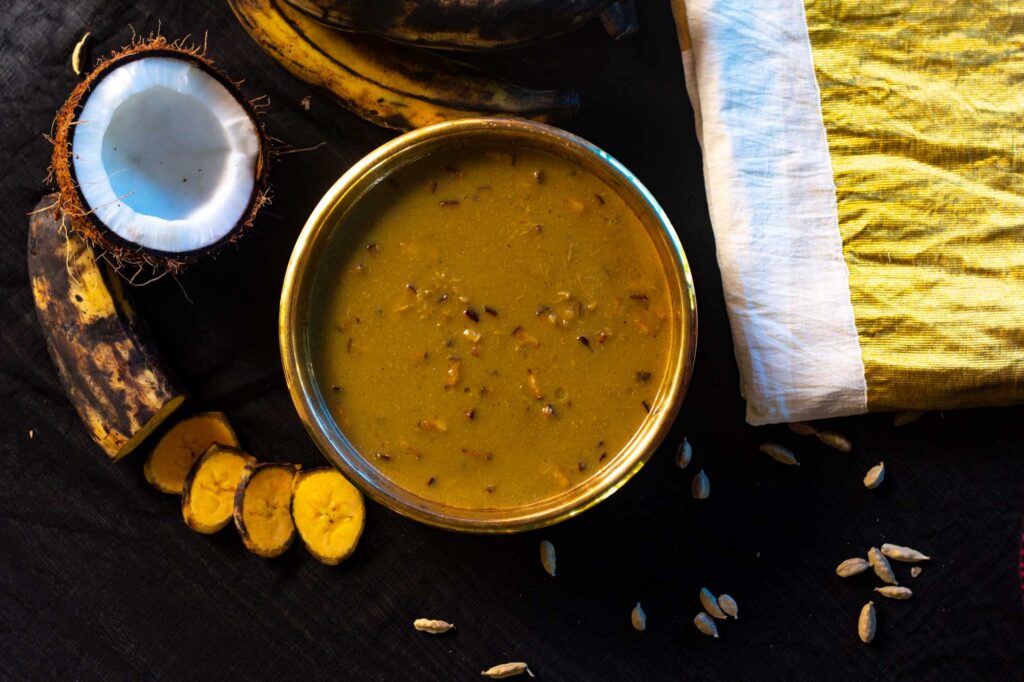Pazham Pradhaman is more than a payasam – it’s the beginning of a story. Before all the modern twists, before condensed milk and shortcuts, there was this: a dessert born from ripe nenthran bananas, jaggery, and coconut – nothing fancy, nothing rushed. Just time, heat, and care.
Some say Pazham Nurukku came before it – a humble preparation where steamed bananas were served with jaggery, grated coconut, and ghee. Soft, warm, and deeply nostalgic. It was simple, but it showed the way. From that came Pazham Pradhaman – fuller, more layered, yet still grounded.
It begins with nenthran bananas, steamed until soft and fragrant. The seeds are gently removed, and the fruit is mashed to a smooth base. This mash is then lightly roasted for a few minutes, just enough to remove its rawness, letting the banana deepen without browning.
Melted jaggery is added and the mixture is stirred and boiled gently until it thickens, reducing slowly, darkening in colour and flavour. Then comes the second coconut milk (randam paal) – thinner and light – poured in to let everything simmer together, absorbing the coconut’s gentle sweetness. This, too, is cooked down until the mixture reduces by half and thickens again.
Now comes the moment of care: the flame is lowered, and the first milk (onnam paal) – thick, rich, full – is poured in slowly. Cardamom powder is added. The pradhaman is stirred softly, but never allowed to boil. The stove is switched off, and the flavours are left to settle – warm, balanced, complete.
Fried bits of coconut, golden cashews, and sweet raisins are added in the end – giving texture to the softness, and a slight crunch to each spoonful.
Pazham Pradhaman holds a delicate sourness from the banana, lifted by the sweetness of jaggery, and rounded by the creaminess of coconut milk. At the end of a sadya, it’s eaten with papadam – a crisp, salty bite against warm sweetness – and somehow, it works perfectly.
This isn’t a fast recipe. It listens to time. It remembers things. And when done right, it becomes more than a dish – it becomes the memory of a home, the voice of an elder, the patience of a kitchen where nothing is rushed.
Pazham Pradhaman
Ingredients
Instructions
-
First, extract coconut milk in three consistencies: thick (1 cup), thin (1 cup), and thinner (1½ cups). Keep them separately.
-
Steam the ripe plantains until soft. Once cooled, slice them into four pieces, remove the seeds, and mash well.
-
Melt 2 cups of jaggery with a tablespoon of water. Strain the syrup to remove any impurities and set it aside.
-
Heat a tablespoon of ghee in a thick-bottomed pan and sauté the mashed plantains for 2 to 3 minutes.
-
Add the strained jaggery syrup to the mashed plantains and stir well. Allow it to boil gently without adding extra water.
-
When it begins to bubble, add 2 teaspoons of ghee and mix everything well.
-
Pour in the thinner coconut milk first and stir continuously to avoid curdling.
-
As the mixture thickens and continues to cook, add the thin coconut milk and combine well.
-
In a small bowl, mix the thick coconut milk with cardamom-sugar powder and stir until well combined.
-
Add this thick coconut milk mixture to the pradhaman and gently stir. Do not allow it to boil after this stage. Switch off the flame and let it rest.
-
For garnish, heat 2 to 3 teaspoons of ghee in a small pan. Fry ¼ cup of coconut strips until golden brown.
-
Add the fried coconut strips and ghee to the pradhaman and mix everything thoroughly.
-
Your rich and fragrant Pazham Pradhaman is ready to be served warm or at room temperature. Enjoy this delightful Kerala classic at your next festive meal.


